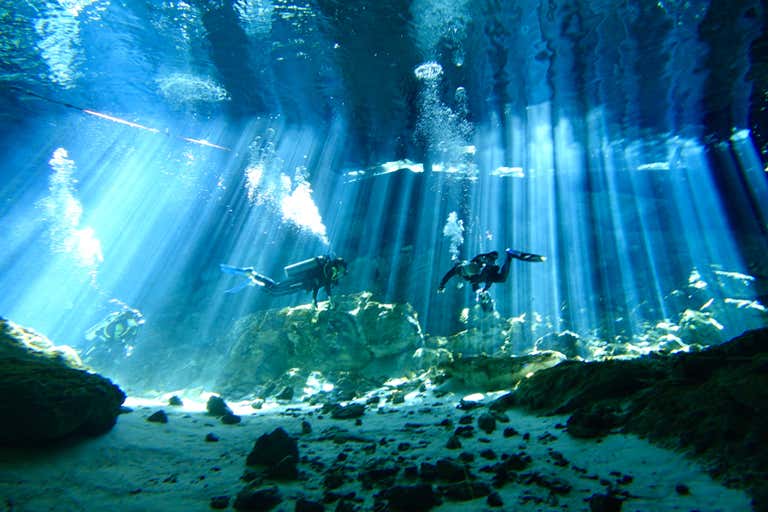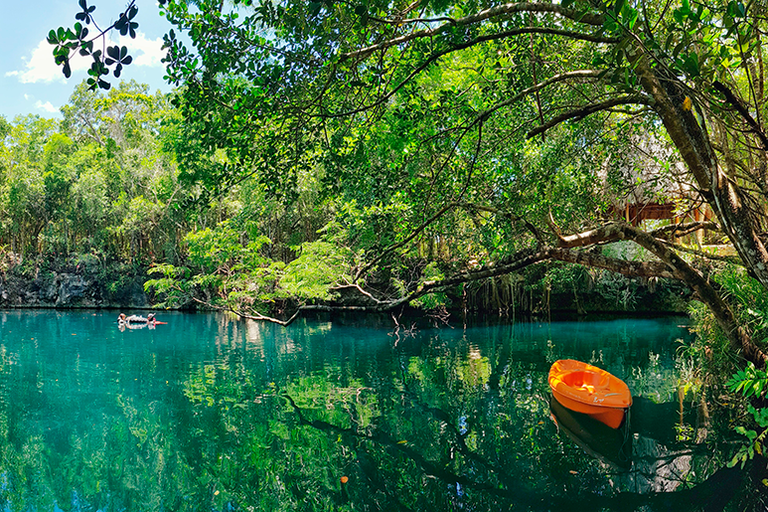A Guide to the Best Cenotes in Mexico: 5 Unmissable Spots

Mexico’s Yucatan Peninsula is home to some of the most incredible sinkholes on the planet known as cenotes. Ranging from enclosed caves to open-air lagoons, these natural pools, home to blue-green waters and lush vegetation, are fantastic places for swimming, snorkeling and diving, and offer a welcome escape from the region’s intense heat.
With upward of around 6,000 cenotes estimated to be in Mexico, where do you start though? From the crystal-clear waters of Dos Ojos to Angelita’s mesmerising underwater world, this guide shares five of the best cenotes in Mexico to quench your curiosity.
What is a cenote?
Cenotes are natural sinkholes that form when the limestone bedrock collapses, exposing the groundwater underneath. The majority of the world’s cenotes — estimates suggest there are between 6,000 to 10,000 — are located in the Yucatan Peninsula in southeast Mexico, where the ancient Mayan civilization viewed them as sacred places and entrances to the underworld. The term “cenote” actually originates from the Mayan word “dz'onot,” which means “cavern with water.”
For the ancient Mayans, cenotes were a vital source of fresh water in an area with limited rivers and lakes. Nowadays, cenotes have become popular destinations for wild swimming, diving, and snorkeling in Mexico.
What makes Mexican cenotes unique?
The Yucatan Peninsula, particularly the area around Mérida, Tulum and Valladolid, is home to some of the world’s longest underground river and cave systems, and the cenotes are the openings that provide access to these underground wonders.
These cenotes are believed to be part of the “Ring of Cenotes,” which marks the rim of the Chicxulub crater — the site of a massive asteroid impact that is believed to have triggered the extinction of the dinosaurs. The impact also caused the collapse of the limestone bedrock, which led to the formation of the sinkholes.
There are four different types of cenotes, and you can find them all in the Yucatan. Cave cenotes are the youngest and are typically enclosed underground. Semi-open cenotes are partially exposed and popular for swimming. Open cenotes are fully exposed to the sky and often surrounded by lush vegetation, and ancient cenotes are the oldest kind and resemble lagoons after centuries of erosion.
When is the best time to explore Mexico’s cenotes?
Ironically, the best time to visit Mexico to soak up its cenotes is during the dry season, which runs from November to April. The weather is usually sunny with minimal rain, which guarantees an overall more enjoyable experience and easier access to the roads leading to remote cenotes.
1. Cenote Dos Ojos, Tulum

Dos Ojos in Tulum is named for its unique double cenote system.
A 14-mile drive from Tulum, Dos Ojos is part of Sac Actún, the world’s largest known underwater cave system, stretching 215 miles. Dos Ojos, meaning “Two Eyes” in Spanish, is divided into two parts: one is home to crystal-clear waters perfect for swimming and snorkeling, and the other is darker and enclosed.
Best time to visit:
Dos Ojos is one of the most popular places to visit in Tulum, so arrive early in the day for the best chance of swimming in peace.
2. Cenote Suytun, Valladolid

Cenote Suytun’s platform is a major draw for photographers.
Five miles east of Valladolid, the semi-open Cenote Suytun is known for its circular stone platform, just beneath a small opening in the cave, where visitors like to take photos. The location is so well-loved that it can be booked by the hour for photo shoots or special events, including weddings! With clear, blue-green waters, it’s also a fantastic spot for swimming.
Best time to visit
For the perfect shot, arrive between midday and 2:00 PM, when the sun shines directly on the platform.
3. Cenote Manati, Tulum

Cenote Manati’s placid waters are ideal for kayaking and snorkeling.
Also known as Casa Cenote, Cenote Manati is located six miles north of Tulum in the Riviera Maya. It’s an open-air cenote, with a narrow shape cutting through a dense mangrove jungle. It’s directly connected to the ocean through underwater tunnels, creating a mix of freshwater and saltwater. Thanks to its vivid and colorful marine life and shallower depths, it is a popular destination for kayaking and snorkeling, and for beginner divers.
Best time to visit
If you are planning to snorkel, head to the cenote on a weekday morning. Weekends tend to be busy, especially during the peak tourist season (December to April) and holidays.
4. Cenote Xcanche, Ek Balam

Ek Balam’s cenote is a short walk from the famous archaeological site.
For a peaceful swim away from the crowds, Cenote Xcanche is one of the best hidden gems in the area. Located near the Mayan ruins of Ek Balam (a 30-minute drive from Valladolid), this semi-open cenote is a spectacle of turquoise waters and lush vegetation-covered walls.
Best time to visit
If you’re planning to combine a visit to the Ek Balam complex with a swim, arrive at Cenote Xcanche before the last entry (usually 3:30 PM).
5. Cenote Angelita, Tulum

Cenote Angelita is an advanced scuba diving site in Tulum.
Just 10 miles south of Tulum, Cenote Angelita is a 200-foot-deep sinkhole that contains some of the most surreal scenery you can find in a cenote. Its waters are filled with floating trees and have a hazy appearance due to a layer of hydrogen sulfide. While swimming here is not recommended, it’s one of the best sites for experienced divers.
Best time to visit
The water remains consistently warm here (around 75 F) year-round, so a 3mm wetsuit is usually sufficient for diving. Rain can affect water visibility though, so try to time your visit with the dry season.


